
- Homepage
- Composition
- Denomination
- Ae Prutah (34)
- Ae3 (14)
- Antoninianus (104)
- Ar Denarius (42)
- Aurelianianus (12)
- Aureus (145)
- Bi Double Denarius (24)
- Bi Nummus (22)
- Centenionalis (16)
- Cistophorus (24)
- Denarius (1282)
- Double Denarius (63)
- Dupondius (16)
- Nummus (121)
- Prutah (27)
- Quadrigatus (13)
- Sestertius (128)
- Siliqua (15)
- Solidus (169)
- Tetradrachm (22)
- Other (606)
- Era
- Grade
- Ruler
- Antoninus Pius (54)
- Augustus (141)
- Caracalla (53)
- Constantine I (57)
- Constantine Ii (29)
- Domitian (58)
- Gallienus (37)
- Gordian Iii (62)
- Hadrian (101)
- Marcus Aurelius (70)
- Nero (114)
- Nerva (31)
- Philip I (66)
- Septimius Severus (36)
- Severus Alexander (69)
- Theodosius Ii (32)
- Tiberius (69)
- Trajan (97)
- Trajan Decius (28)
- Vespasian (78)
- Other (1617)
- Year
NGC Ch XF ROMAN COINS FAUSTINA Sr. AD 138-140/1. AR Denarius. MAX/036
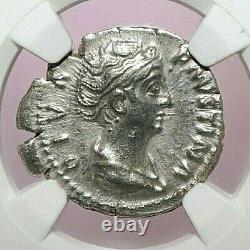
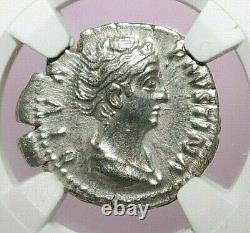
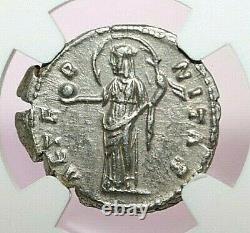
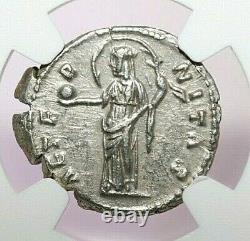
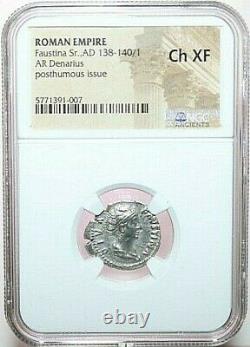
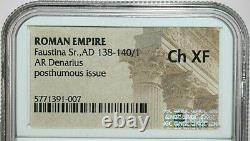


Dear Customers, you will receive exactly the same item which you see on the pictures, not similar or other. Please read the description carefully and review the photos. Bust of Faustina Major in the Altes Museum (Berlin).
Empress of the Roman Empire. October or November 140 (aged 40) near Rome. Marcus Aurelius Fulvius Antoninus (died before 138). Marcus Galerius Aurelius Antoninus (died before 138).
Aurelia Fadilla (died in 135). Annia Galeria Faustina Minor or Faustina the Younger. Annia Galeria Faustina the Elder , sometimes referred to as Faustina I (born on February 16 around 100 CE: died in October or November of 140 CE), was a Roman empress and wife of the Roman emperor.Was her nephew and later became her adopted son, along with Emperor Lucius Verus. She died early in the principate of Antoninus Pius, but continued to be prominently commemorated as a diva.
Posthumously playing a prominent symbolic role during his reign. Faustina was the only known daughter of consul. And prefect Marcus Annius Verus. Her brothers were consul Marcus Annius Libo.
Her maternal aunts were Roman Empress Vibia Sabina. Her paternal grandfather was named Marcus Annius Verus, like her father, while her maternal grandparents were Salonia Matidia. Niece of Roman Emperor Trajan. And suffect consul Lucius Scribonius Libo Rupilius Frugi Bonus.Faustina was born and raised in Rome. While a private citizen, she married Antoninus Pius between 110 and 115 CE.
Faustina bore four children with Pius: two sons and two daughters. Marcus Aurelius Fulvius Antoninus (died before 138); his sepulchral inscription has been found at the Mausoleum of Hadrian. Marcus Galerius Aurelius Antoninus (died before 138); his sepulchral inscription has been found at the Mausoleum of Hadrian in Rome. He is commemorated by a high-quality series of bronze coins, possibly struck at Rome, though their language is Greek. Aurelia Fadilla (died in 135); she married Aelius Lamia Silvanus or Syllanus.
She appears to have had no children with her husband and her sepulchral inscription has been found in Italy. (between 125-130 to 175), a future Roman Empress; she married her maternal cousin, future Roman Emperor Marcus Aurelius. She was the only child who survived to see Antoninus and Faustina elevated to the imperial rank. According to the unreliable Historia Augusta. There were rumours while Antoninus was proconsul of Asia. That Faustina conducted herself with "excessive frankness and levity". Bust of Faustina in the Musei Capitolini (side view; note the distinctive hairstyle). On July 10, 138, her uncle, the emperor Hadrian. Died and her husband became the new emperor, as Antoninus was Hadrian's adopted son and heir. Faustina became Roman Empress and the Senate accorded her the title of Augusta. As empress, Faustina was well respected and was renowned for her beauty and wisdom. Throughout her life, as a private citizen and as empress, Faustina was involved in assisting charities for the poor and sponsoring and assisting in the education of Roman children, particularly girls. Has sometimes been taken as an index of the latter's devotion to her. After Antoninus Pius' accession to the principate, the couple never left Italy; instead, they divided their time between Rome, Antoninus' favourite estate at Lorium.And other properties at Lanuvium. Faustina's personal style was evidently much admired and emulated.
Her distinctive hairstyle, consisting of braids pulled back in a bun behind or on top of her head, was imitated for two or three generations in the Roman world. Several provincial groups chose to honour her while she was empress: a company of couriers in Ephesus. Named themselves after her, while a company of clapper. Players in Puteoli dedicated an altar to her in her own lifetime.
Statue of Faustina the Elder at Herodes Atticus. Faustina died near Rome in 140, perhaps at Antoninus Pius' estate at Lorium. Antoninus was devastated at Faustina's death and took several steps to honor her memory. He had the Senate deify her. Was portrayed on an honorary column.And dedicate the Temple of Faustina. To her in the Roman Forum. Because of this, Faustina was the first Roman empress with a permanent presence in the Forum Romanum. The Senate authorized gold and silver statues of her, including an image to appear in the circus.
Where it might be displayed in a carpentum (a kind of covered waggon) or currus elephantorum (a cart drawn by elephants). Antoninus also ordered various coins with her portrait struck, inscribed. ("Divine Faustina") and elaborately decorated.
He also established a charity called Puellae Faustinianae ("Girls of Faustina") to assist orphaned Roman girls and created a new alimenta see Grain supply to the city of Rome. Her remains were interred in the Mausoleum of Hadrian. Certain cities struck coin issues in honour of the "divine Faustina" Ancient Greek. ; the most notable such cities were Delphi.
Martin Beckmann suggests that the coins of Nicopolis might have been minted at Rome and given out as imperial largesse at the Actian Games. The coins issued in the wake of Faustina's funeral illustrate her elaborate funeral pyre, which may have influenced the design of later private mausolea; the deities Pietas. Among others; and an eagle (or less often a winged genius) bearing a figure aloft, with the legend.
Faustina's ascension into heaven. Coins of Faustina were sometimes incorporated into jewellery and worn as amulets. A denarius struck in honour of Faustina Major, depicting her temple. (temple of the divine Faustina). Depiction of Pius and Faustina being borne aloft on the back of a winged figure. From the base of the Column of Antoninus Pius. The posthumous cult of Faustina was exceptionally widespread, and Faustina's image continued to be omnipresent throughout Antoninus Pius' principate. A colossal marble head, believed to be that of Faustina and discovered in 2008, figured as one of several monumental imperial statues at the ancient site of Sagalassos. Dedicated a nymphaeum that displayed statues of Faustina and other Antonines as well as his own ancestors. Faustina also appears on the Parthian Monument.At Ephesus commemorating members of the imperial family. Bergmann and Watson have characterized the commemoration of Faustina as central to Antoninus Pius' political persona.
One larger-than-life statue, discovered in situ near the Termini railway station at Rome, appears to depict Faustina as Concordia. And cornucopia; it would have been displayed alongside statues of Diana Lucifera.
Privately owned but available to the public. Antoninus and Faustina were officially held up as such exemplars of conjugal harmony that newlyweds were directed to pray at an altar of Antoninus and Faustina that they might live up to their example. This was evidently the case in Ostia, and probably so in Rome. Is thought to have been dedicated in 144 CE.
It is a grand hexastyle. Possibly designed originally to be a temple of Ceres.
Depictions on coins appear to show a cult image of Faustina seated on a throne and holding a tall staff in her left hand. Faustina's portrait on coins from this period is often crowned as well as veiled, which may also recall a feature of Faustina's cult image from the temple. The church of Sant'Urbano alla Caffarella.
Near Rome, originally built as a private shrine of Ceres and Faustina. The deified Faustina was associated particularly closely with Ceres. Who featured prominently on coins of Faustina; for some years, the torch-bearing Ceres was the dominant motif in her gold coinage. Herodes Atticus venerated Faustina as the new Demeter. (the Greek equivalent of Ceres) at a private sanctuary he established outside Rome, now the church of Sant'Urbano.
In addition to Ceres, Vesta. Feature prominently in Faustina's coinage. She was also associated with the Magna Mater. And at Cyrene with Isis. She was worshipped conjointly with Artemis.
Ten years after Faustina's death, a new commemorative coinage was introduced, featuring the legend Aeternitas. ('eternity'); such coins may have been introduced to be distributed at a public ceremony in her memory. After Antoninus Pius' death, his adoptive sons and successors Marcus Aurelius.
Erected the Column of Antoninus Pius. Which dramatically depicted Antoninus and Faustina being elevated heavenward together on the back of a winged figure. Faustina continued to be commemorated in certain Renaissance depictions as a model wife. The item "NGC Ch XF ROMAN COINS FAUSTINA Sr. MAX/036" is in sale since Tuesday, February 2, 2021.This item is in the category "Coins & Paper Money\Coins\ Ancient\Roman\ Imperial (27 BC-476 AD)".bean_medals" and is located in Riga, centrs.
This item can be shipped worldwide.
- Cleaned/Uncleaned: Cleaned
- Modified Item: No
- Composition: Silver
- Certification Number: 5771391-007
- Ruler: Faustina I
- Historical Period: Roman: Imperial (27 BC-476 AD)
- Certification: NGC
- Provenance: Ownership History Not Available
- Denomination: Denarius
- KM Number: 5771391-007
- Date: AD 138-140/1
- Era: Ancient
- Grade: Ch XF
- Year: AD 138-140/1

